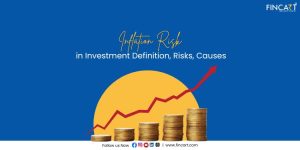Your investments can experience losses due to unfavourable price movements that affect financial markets as a whole. This possibility is called market risk, and it is an inherent part of investing. In this blog, we’ll talk about what market risk means, how it impacts your investments, explain market risk types, and understand how one can manage it.
What is Market Risk?
To put it simply, market risk meaning can be understood as the risk of losing money on an investment. It affects the entire market, not just a handful of companies or sectors. But in technical terms, we can define market risk as the potential for an investor to suffer losses due to various aspects that affect the overall performance of the financial markets. These aspects cover a wide range of situations such as inflation, changes in interest rates, policy and political changes, geopolitical events, fluctuations in currencies, wars, pandemics, natural disasters, recessions, and general market sentiment.
Largely, there are two types of investment risks – market risk, also called systematic risk, and unsystematic risk. Unsystematic risk is a type of risk specific to a particular company or sector. It can be directly linked to the performance of a specific security, and that’s why diversification can help easily manage it. On the other hand, systematic risk has an effect on the entire financial market, and thus cannot be managed through diversification.
Types of Market Risk
There are many types of risk in financial markets, such as market risk, credit risk, business risk, operational risk, liquidity risk, and legal risk. However, when it comes to market risk types, there are broadly four categories:
Equity Risk
Markets can be volatile, meaning prices of stocks, commodities, and currencies can change quickly. Equity risk is the chance of losing money because of stock price changes in the market. If the market performs poorly and stock exchanges go down a few points, the value of your investments can drop. This risk is an important consideration for individuals investing in equity related instruments such as stocks and equity mutual funds. These prices fluctuate in the short term but tend to stabilise over the long term.
Interest Rate Risk
This type of risk affects bonds and other fixed-income debt instruments. Interest rates can change from time to time due to many reasons. In cases where the interest rates rise, the value of existing bonds falls. This is because the newly issued bonds offer higher interest payments, which makes older bonds with lower rates less attractive to investors. Similarly, when the interest rates fall, the older bonds become more appealing as they pay out higher returns compared to the newer ones.
Currency Risk
Also known as exchange rate risk, this type of risk affects investors holding foreign investments. If the price of a currency falls in relation to another, this risk arises. For example, if Rupee’s value goes down against USD, an investor holding a US investment can lose money when he converts his returns into Rupees.
Commodity Risk
Commodities are metals, minerals, raw materials, and agricultural products that are bought and sold. This type of risk involves the chance of losing money due to the fluctuations in the prices of these commodities. For example, if the price of oil rises due to a conflict in the Gulf region, it can lead to increased costs for companies that rely on oil and lower their profits.
Examples of Market Risk
Market risk can arise from several factors such as politics, policy changes, natural disasters, wars, pandemics, and other economic changes. These factors have the potential to cause market downturns. An example of market risk can be the global financial crisis of 2008. This happened in the US due to the subprime mortgage crisis. Major financial institutes in the US collapsed, and in turn, so did markets around the world.
A similar, but smaller in scale situation happened when the UK decided to leave the European Union. This was caused due to politics, which ultimately had a big impact on the market. We’ve also experienced market risk in recent years – when the world came to a halt in 2020 due to the COVID-19 pandemic. Stock markets across the globe saw sharp declines due to an unpredictable health crisis.
Factors Contributing to Market Risk
1. Interest rate changes
Interest rates are regulated by central banks like the RBI. When RBI raises the interest rates, the cost of borrowing for businesses increases, which means the economy slows down. This has a big impact on mainly debt assets such as bonds. As the interest rates rise, the value of existing bonds decreases.
2. Political factors
Changes in governments and policies can create a feeling of uncertainty in the markets. Elections, political instability, and shifts in economic policies can lead to higher market volatility. For example, new taxation policies can affect a business’s profits and investors’ behaviour.
3. Geopolitical factors
Changes in a foreign country’s economic policies can increase currency risk. Acts such as sanctions and wars also play a huge role in increasing uncertainty and market risk.
4. Natural disasters
Such occurrences cannot be predicted, but when they do happen they have the potential to leave their mark on investors’ portfolios.
5. Pandemics
The memory of COVID-19 is fresh in everyone’s mind. These crises can have severe impacts on how businesses and governments operate, consumers spend, and markets perform.
6. Technological innovation
New technology has the potential to make a business more efficient and profitable, but at the same time, it can also render a business obsolete. For example, the artificial intelligence boom in the past few years has changed many industries for the better. However, businesses and sectors that have failed to adapt to these technological advancements find themselves struggling to compete, which has led to falling stock prices and increased market risk.
How to Measure Market Risk
Many different methods can be used to quantify market risk. Here are two popular methods used by analysts:
1. Value at Risk (VaR)
VaR basically tells you about the possible worst-case loss you could face. Through VaR, you can measure how much money you can lose in your investment portfolio over a certain period of time. For example, if a portfolio has a 7 day VaR of Rs. 2 lakh at a 95% confidence level, it means there’s a 5% chance that the portfolio could lose more than Rs. 2 lakh in seven days.
2. Risk Premium
This measure tells you about the extra returns you can earn by investing in risky investments compared to risk-free investments like fixed deposits. Basically, it measures the reward for choosing a riskier option over a safer one. For example, if a safe investment like government bonds gives you a 6% return and a riskier investment like equity funds offers 14%, the risk premium is the 8% difference between the two.
Impact of Market Risk on Investments
Here’s how market risk impacts different asset classes:
1. Equities
Stock prices can experience a sharp rise or decline when markets are highly volatile. Investment vehicles that invest primarily in equities can be vulnerable to equity risk. Investors can also use this period of volatility as an opportunity to invest in undervalued companies.
2. Debt (Bonds)
Instruments such as bonds are vulnerable to interest rate risk. If the interest rates rise, the value of existing bonds goes down, and vice versa. Those holding long-term bonds are particularly vulnerable to interest rate risk.
3. International investments
If the value of the domestic country’s currency depreciates compared to that of the country you are investing in, you can lose money when you eventually convert currency. These types of investments can experience exchange rate risk or currency risk.
4. Commodities
Investments such as oil and agricultural products can be affected by commodity risk, which can be caused due to factors like the weather, wars, disasters, sanctions, and other market forces.
Strategies to Manage Market Risk
One cannot completely eliminate market risk, however, there are ways you can minimise its impact:
1. Keep an eye on interest rates
This is crucial for investors with a bond heavy portfolio. If you think the interest rates will soon rise, avoid investing in long-term bonds and shift focus to short-term fixed-income instruments.
2. Watch currency profile
If you are investing in foreign markets, you need to keep a careful watch on exchange rates, as foreign investments can be vulnerable to currency risk.
3. Maintain liquidity
It can be hard to sell or buy an asset at the price you want when the market is volatile. It is especially tough to sell an asset quickly during such times. You can choose stocks with lower impact costs to make trading easier and ensure you can buy or sell them more smoothly.
4. Keep a long-term perspective
The volatility experienced by equities tends to even out in the long run. The longer you stay invested, the more likely your portfolio will recover from short-term losses.
5. Consider SIP
Through Systematic Investment Plans, you invest a fixed amount regularly in a suitable mutual fund and enjoy the benefits of rupee cost averaging. When the market is down and the prices are lower, you’ll buy more units for the amount you’ve committed to investing regularly and vice versa when the markets are up. While this does not protect you against market risk, it does give you a way to reduce its impact in the long run and allows you to take advantage of low costs.
Protect What Matters Most!
Contact Fincart for tailored insurance and risk management solutions to safeguard your future.
Conclusion
Market risk is the chance of losing money on your investment due to factors that affect the performance of markets, like political changes, regulatory changes, geopolitical events, pandemics, interest rate fluctuations, and more. You can’t completely eliminate market risk but there are ways you can manage it – such as through hedging and keeping a long-term perspective. If you want to earn high returns, you will have to take on a high level of risk.
However, the good news is that over the long term, this risk tends to go down and you still get to reap the high rewards. Vehicles such as fixed deposits and government bonds indeed offer safety, but they offer lower returns compared to riskier investments, making wealth creation harder.
Investors often worry about market risk, sometimes because they don’t understand it and other times because they know someone who lost a lot of money investing in high-risk options. However, market risk, like any financial risk, can be managed. You should never exceed your risk tolerance, but discussing your concerns with a financial advisor can be beneficial. They can share strategies for managing risk and guide you in making safe investment choices for a more secure financial future.




